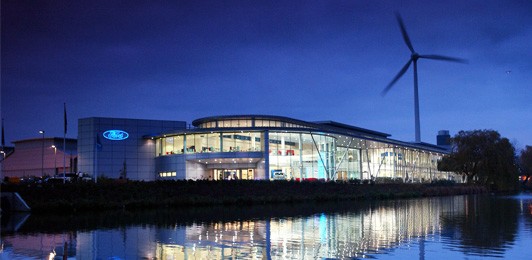Renewable Energy
Ford is actively involved in the installation, demonstration and development of alternative sources of energy.
Ford’s Genk plant in Belgium is partly powered by two wind turbines installed by local energy company Electrabel. Each unit has an output of 2 MW of power, which is used in the manufacture of the Ford Mondeo, S-MAX and Galaxy models. Furthermore, all other electrical energy supplied by Electrabel used at the Genk plant comes from renewable sources.
Ford’s Dagenham Diesel Engine Assembly line in the UK was the first automotive plant in the world to obtain all of its electrical power needs from two on-site wind turbines, which have been in operation since 2004. A third 2 MW wind turbine was installed in 2011.

Dagenham Diesel Centre, UK
A few miles from Dagenham, Ford’s Dunton Technical Centre is also powered by electricity from renewable sources. Since March 2009, electric power on the 270-acre site, which is home to a team of approximately 3,000 engineers, has been purchased from 100 percent renewable sources. The majority of the electricity, supplied by GDF, is sourced from a combination of hydro, wind and waste-to-energy generation, and replaces energy from traditional sources that would have produced an estimated 35,000 metric tons of CO2 emissions annually.
Since 2008, Ford has been sourcing renewable electricity to cover the full electric power demand of its manufacturing and engineering facilities at its Cologne plant in Germany. This includes the electricity needed for the assembly of the Ford Fiesta models at the plant. Through this initiative, the Company has reduced its CO2 emissions by 190,000 metric tons per year.
In Wales, Ford’s Bridgend Engine Plant was the first site retrofitted with one of the largest integrated, grid-connected solar/photovoltaic installations at a car manufacturing plant in Europe.
In North America, examples of installed renewable-energy technologies include a photovoltaic array and solar thermal collector at the Ford Rouge Visitors Center. The adjacent Dearborn Truck Plant has a “living roof” system, which uses a thick carpet of plants to reduce the need for heating and cooling, while also absorbing rainwater. At the Lima Engine Plant in Lima, Ohio, a geothermal system provides process cooling for plant operations as well as air tempering for employee comfort. This system uses naturally cooled 40°F water from two abandoned limestone quarries located on the plant site. The installation cost was comparable to that of the traditional chiller and cooling tower design that it replaced. This award-winning project eliminates the emission of 4,300 metric tons of CO2 each year. In addition, we continue to use a landfill gas installation at the Wayne Assembly Plant.
At our Michigan Assembly Plant, we are building a smart renewable power storage system. We are collaborating with DTE Energy to build this stationary, battery-based energy storage facility, which will combine a 500 kW solar photovoltaic array with a 750 kW storage system to deliver 2 MW of energy. This project will provide vital knowledge from a real-world integration of renewable energy, smart-grid technologies and battery storage infrastructure. For more on this project, please see Partnerships and Collaboration.
In 2012, we installed a solar-powered trash compactor at our Michigan Proving Grounds in Romeo, Michigan, which compresses waste more efficiently than the previous one. The resulting compacted waste is sent to an incinerator where it is converted into power for local residents. Please see the Waste section for more information on this technology.
In India, we are using solar thermal heating at the Chennai plant to heat water for cooking in the main cafeteria. Using this system, sterilized water is pumped through thermal solar panels and then taken to the cafeteria for cooking at approximately 50°C higher than water that was previously used in cooking boilers. This system has reduced boiler diesel consumption by approximately 420 liters per day. The system, which was installed in spring of 2011, is expected to pay itself back in four years.
